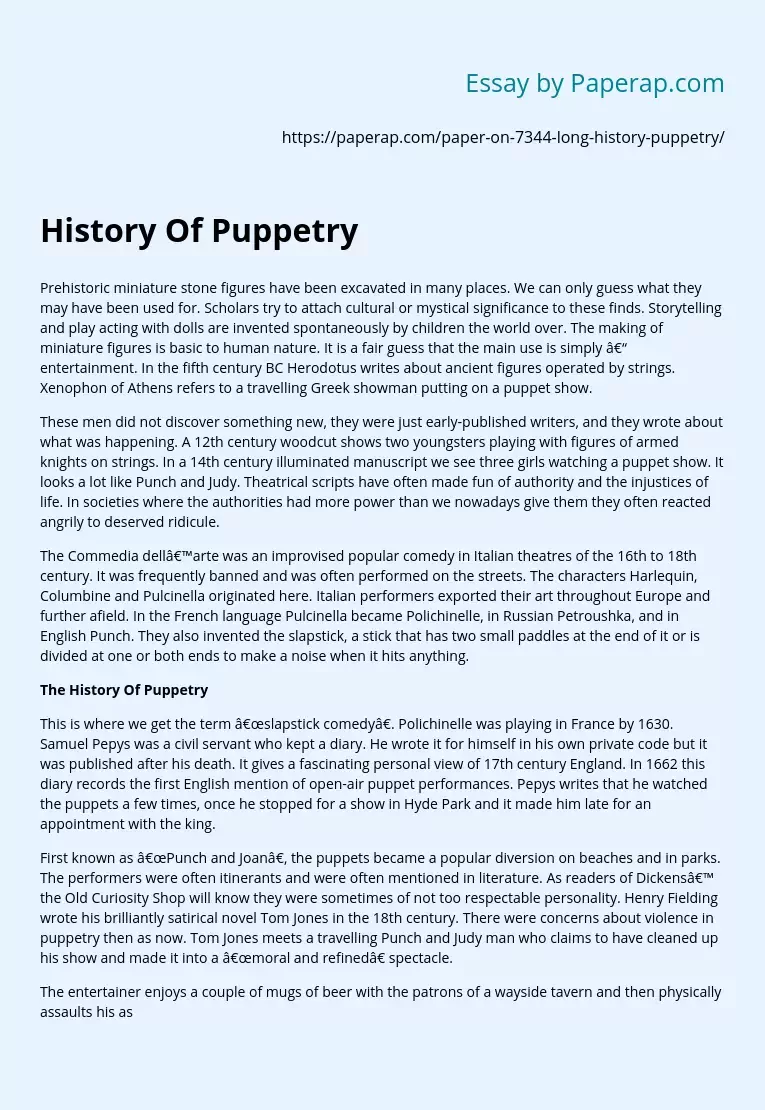Prehistoric miniature stone figures have been excavated in many places. We can only guess what they may have been used for. Scholars try to attach cultural or mystical significance to these finds. Storytelling and play acting with dolls are invented spontaneously by children the world over. The making of miniature figures is basic to human nature. It is a fair guess that the main use is simply – entertainment. In the fifth century BC Herodotus writes about ancient figures operated by strings.
Xenophon of Athens refers to a travelling Greek showman putting on a puppet show.
These men did not discover something new, they were just early-published writers, and they wrote about what was happening. A 12th century woodcut shows two youngsters playing with figures of armed knights on strings. In a 14th century illuminated manuscript we see three girls watching a puppet show. It looks a lot like Punch and Judy. Theatrical scripts have often made fun of authority and the injustices of life.
In societies where the authorities had more power than we nowadays give them they often reacted angrily to deserved ridicule.
The Commedia dell’arte was an improvised popular comedy in Italian theatres of the 16th to 18th century. It was frequently banned and was often performed on the streets. The characters Harlequin, Columbine and Pulcinella originated here. Italian performers exported their art throughout Europe and further afield. In the French language Pulcinella became Polichinelle, in Russian Petroushka, and in English Punch. They also invented the slapstick, a stick that has two small paddles at the end of it or is divided at one or both ends to make a noise when it hits anything.
The History Of Puppetry
This is where we get the term “slapstick comedy”. Polichinelle was playing in France by 1630. Samuel Pepys was a civil servant who kept a diary. He wrote it for himself in his own private code but it was published after his death. It gives a fascinating personal view of 17th century England. In 1662 this diary records the first English mention of open-air puppet performances. Pepys writes that he watched the puppets a few times, once he stopped for a show in Hyde Park and it made him late for an appointment with the king.
First known as “Punch and Joan”, the puppets became a popular diversion on beaches and in parks. The performers were often itinerants and were often mentioned in literature. As readers of Dickens’ the Old Curiosity Shop will know they were sometimes of not too respectable personality. Henry Fielding wrote his brilliantly satirical novel Tom Jones in the 18th century. There were concerns about violence in puppetry then as now. Tom Jones meets a travelling Punch and Judy man who claims to have cleaned up his show and made it into a “moral and refined” spectacle.
The entertainer enjoys a couple of mugs of beer with the patrons of a wayside tavern and then physically assaults his assistant. Fielding has his hero comment that he much preferred the show in its old form. George Cruikshank, who made a name for himself by illustrating the writings of Charles Dickens was involved in the production of a book that preserved a street performance of a Punch and Judy show. Cruikshank and publisher John Payne Collier hired an Italian performer, Signor Piccini, to put on a private show in the King’s Arms, a tavern in Drury Lane, London.
The show was stopped frequently so that Cruikshank could make drawings and Collier could record the dialogue. Both of these illustrations are by Cruikshank. Piccini may or may not have been an Italian. Then, as now, entertainers sometimes invented exotic names and backgrounds for themselves. He was a great puppeteer. He could have one of his puppets take off his hat with one hand, throw it to the other hand, and put it back on his head. Punch and Judy proliferated in the 19th and early 20th centuries. Shows were seen everywhere and some of the performers became prosperous.
History Of Puppetry. (2019, Dec 05). Retrieved from https://paperap.com/paper-on-7344-long-history-puppetry/

